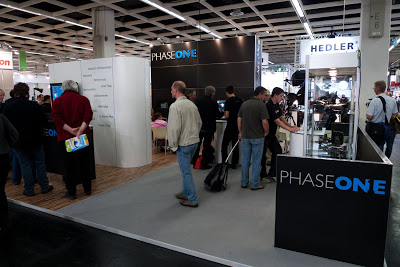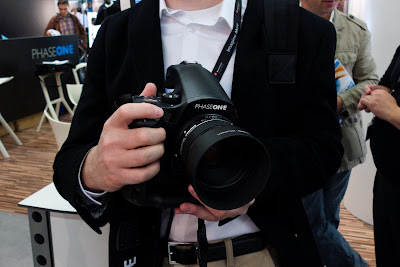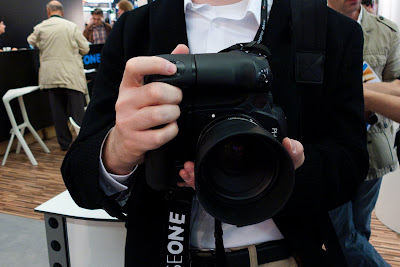[COLOR=#333333][FONT=Trebuchet MS]With all day yesterday spent at the Leica booth and with Hasselblad's announcements today, I figured I'd try to check out the S2's main competition.
Phase One
First on the tour was Phase One. Their booth was much smaller and more basic for this show than they had in the past. Not too much product, not a lot of visitor space, mostly meeting tables. There was a live photo area with a model sporting biker wear and attitude, as well as a still life setup. The new Schneider 120mm T/S was being shown, but not the newly announced autofocus 120mm Macro or 35mm D. The main attraction seemed to be the V-Grip Air vertical grip for the Phase One 645DF (Mamiya 645DF). Sporting a serial number of C00001, I'm assuming this is the first one of its kind, but not the only one.
The grip feels to be made out of the same plastic and rubber material as the DF body and does match nicely with the camera. It is wide and tall, with a sharp recess for your fingers in the front. They've done a nice job of cutting out resting finger positions on the front as well as the rear for your thumb. I did find it a bit odd and non-ergonomic that the rear thumb dial and AF/AE button were placed so far to the right of your resting thumb position. Given the weight of the camera and torque exerted when holding the camera in vertical, you would lose your balance by moving your thumb out of the rear groove to the outside of the grip in order to access these controls.
The front shutter button placement is good, with a little function button accessible on the underside of the front of the grip which you can activate with your middle finger.
On the rear of the V-Grip are controls for switching the camera power source from the lithium battery inside the grip or the AA batteries inside the riser portion. This marks the first time that 645DF users can use the same battery type to power the camera as they do for the back, without having to carry AA cells. But of course, for those still yearning for nostalgia and extra weight and bulk, the AA option remains. I didn't notice if the camera top status LCD had a battery status, but I do think it would be a smart idea if the V-Grip/DF body could auto switch between battery types. When I picked up the camera with the grip on, the back was powered on, but the camera wouldn't turn on. There were no AA installed, but the selector switch was in the AA position. The camera powered on after the switch was flipped over to Li+, but this seems an unnecessary step to take, especially if there is no indication without physically removing the V-Grip from the camera to check for batteries.
To the right of the power selector switch is the thumb dial for attaching the unit to the base of the camera. Standard issue and no surprises here. To the right of that is a switch allowing for either standard or fast Profoto Air Sync.
On the left-hand side is a flip-out access door, under which the lithium battery goes in. Also there is a dial control for the Air channel from 1 to 8 as well as off. A mini-USB port provides the user, for the first time, the ability to upload firmware to the camera without having to send the body in to service.
[LEFT]
The particular unit I had powered the camera, but the shutter release would not activate. I was instructed to use the camera's main release button instead and that this was just trade show quirkiness.
Holding the camera by the grip felt okay, but the camera is quite top-heavy in horizontal which is fine, but when rotated, exerts a fair amount of left-pulling torque on your right wrist. It is a similar feel to holding a Hasselblad H body with a heavy lens mounted. Fine for a short duration, but could start to be a strain if shooting for extended periods of time. For the price ($1290), the grip feels a bit plastic, but it does offer 645DF owners a good way to rid themselves of AA batteries, offers the unique Profoto Air triggering, and the ability to perform body firmware updates themselves. If previous Phase One marketing strategy holds true, I'm sure it will end up being bundled with a standard camera, back and 80mm lens for much less than if purchased separately.
I didn't shoot with the 120mm T/S lens or see the quality it produced, but I did hold it in my hands to get an idea of the size and weight. As mentioned previously, the lens is extremely large but very, very light. For those needing such a lens for field work, the weight will not be a problem, but some might find the bulk to be a factor. I'll be interested to see what kind of results this lens is capable of.
Hasselblad
Leaving Phase, I ventured onward and headed over to the Hasselblad booth. These guys always have a great stand at Photokina and this year is no exception. It also was a bit smaller than the one in 2008, but the size was compensated by the presence of a sweet Ferrari convertible and regularly scheduled runway models mugging for cameras. Compared to Phase, there were a lot more people packed into the booth looking at a lot more product. Hasselblad had no shortage of display product or helpful people to answer any questions.
I handled the H4D-40, 50 and 60, which are all basically the same, except for the sensor inside. I've used most of the HC lenses before and I am very familiar with the H3 body, so no surprises here. The main difference between the H3 and the H4 is True Focus, which is Hasselblad's clever way to compensate for focus shift during focus-and-recompose using accelerometers to record camera rotation during reframing and compensating focus on the fly before taking the picture. I think that Hasselblad should be applauded for bringing some ingenuity to the medium format party.
I was very curious on the H4D60 to see how the “double-res” LCD looked, both relative to the “single-res” screen on every other H back or the same-sized S2 LCD. The new LCD offers some improvement in terms of resolution, but I still feel that the color saturation and contrast of the screen is lacking. It still looks a bit hazy, not as much as the Leaf Aptus II LCD, but not nearly as clear and nice as the Leica S2's screen. I read and hear a lot of complaints about medium format LCD quality, yet strangely, the manufacturers are still unresponsive to this request. Phase One seems to be the worst of the bunch, still offering an LCD that looks like it came from a Nikon D70 c. 2004.
I was also interested to see playback speed and zoom on the rear LCD of the H4D versus the S2. Preview images display in 1-2 seconds, so this is pretty quick. Hassy has certainly made some significant speed improvements on this latest generation of backs, but there is still about a 5-6 second delay when zooming in to 100% to check focus. The S2 by comparison zooms in to the image in real time, without delay.
Hasselblad announced some new products for Photokina today. The first is a “new” camera, the H4D31. This is a new entry-level kit that combines the exact same back as the H3DII-31 with the latest H4 camera with True Focus. They are looking to sell this kit for 10,000 EUR, which should translate to about $13,000 USD, but US pricing hasn't been set yet.
The HC 50mm f/3.5 and the HC 120mm f/4 Macro have been redesigned. Both lenses look identical to the previous (current) models, except for the “II” designation in the name. All of the changes are internal. The 50mm brings an increase in resolution and corner performance, while the 120mm Macro improves color performance, eliminating axial chromatic aberration. As digital sensor increase in resolution and physical size, more and more demand is being placed on the lenses. It is nice to see Hasselblad focus on optical improvement rather than a software correction approach.
They also announced a 200MP virtual resolution camera, the H4D50MS. The MS stands for multi-shot, meaning that while remaining perfectly still, the sensor shifts in microscopic increments to introduce more information. The process of shooting six exposures takes about two minutes. Applications for this would be things like artwork reproduction where the subject, camera, and illumination source all remain consistent. Not so well suited for any subject which moves or where lighting can't be controlled precisely.
And, for lovers of the V system, Hassy has a got a new back, the CFV50 featuring the same Kodak sensor found in the H4D50. This should be nice as the sensor is physically larger than the CFVII-39, giving some more utility to wide-angle lenses like the 40mm CFE-IF.
Last, but not least, Hassy is introducing a special edition Ferrari camera. Painted in Ferrari Red and limited to 499 pieces, price is “available upon request.” I didn't request it. See, Leica isn't the only company offering special edition cameras.
I also had never tried the 35-90 lens and I have been hearing good things about it. It's really, really huge. Not as bulky as the 50-110, but big. I'm not sure how comfortable I'd be carrying this around all day.
Leaf
From Hall 2.1 where Leica, Hasselblad and Phase One are located, I ventured to Hall 9 where I will be going tomorrow to look at lighting, supports, and other photo accessories. Amidst the sea of photo accessories and off-brand monlolights was the Leaf booth. I honestly couldn't believe this booth wasn't packed. The Leaf Aptus-II 12 has set a new level of resolution with 80 MP in a full-sized 645 chip, but the booth was quiet.
I spoke to product manager Yair Shahar, who couldn't have been nicer. He recognized me from my photo online and the two of us have crossed paths on online photography forums many times. It was nice to finally put a face to a name.
He told me about the new Dalsa sensor in the Aptus-II 12. The sensor has a 5.2 µm pixel pitch and features next-generation imaging performance. They worked closely with Dalsa to develop this sensor and I get a sense that Leaf, and by association, Phase One, will have some period of time of exclusivity on the technology. Already, Hasselblad lagged for almost two years behind Phase One's P65+ with their H4D60, which has just recently come to market (even though it was announced at the last show). I expect to see a similar situation here. I asked about smaller sensors being offered with the 5.2 µm pixels. Yair seemed to feel that the goal has always been getting to full frame and that they should stay there.
We looked at some images on a computer screen from the new 80MP back. They do look like multi-shot images I have seen and that is Leaf's claim. The sample was a picture of a bunch of fabrics and there was no moiré. Every time I moved the image to scroll around, it Leaf Capture software would have to re-render that new section and the system was clearly dragging. Yair said that the support for the back is still in beta and he feels this is just an early software glitch. I was wondering if these kind of files were just too unwieldy for the iMac to handle.
I do wish that Leaf would put more effort into updating the camera interface, speed of operation, battery life and the quality of the LCD. They were one of the first companies making medium format digital backs and have made some significant technological advances. Faster processing, better LCD and more robust battery life would all be welcome by Leaf shooters. In the case of the new back, the LCD, interface and battery life remain the same as the rest of the lineup. This is not anything new for medium format backs and is not exclusive to Leaf. You could change the sticker on any Phase P back and impress your friends and clients – they'd never know your five-year old P25 isn't really a P65+.
Leica – Something new
I stopped in at the Leica booth as I had some follow-up meetings. I saw a small still life diorama in a box with an S2 pointed at it, which was tethered to an adjacent PC, looking very much like a science fair display. The young lady who was running the demo is a student at Cologne University of Applied Science. Leica works closely with this school to develop both algorithms and talent. Many of the top engineers and product managers came from the school.
So, what was the science project about? High Dynamic Range, more commonly referred to as HDR. This got my interest, so I requested the full demo.
Working with a modified version of Leica Image Shuttle, a new HDR tab has been added. With a single click, the camera will first shoot one or two shots to analyze the scene and determine how many shots and with what exposure parameters are required to deliver the entire luminance range of the scene, then actually fire off the sequence automatically. Once the button was clicked, the camera went into autopilot and shot six frames with three stop spacing. Sure, anyone can do exposure bracketing then blend the resulting captures in Photoshop or Photomatix, but here is the best part of all: the resulting file is a 24-bit per pixel DNG file. Yes, 24-bit raw file with the same handling of any DNG from the S2. After the sequence was completed, a progress bar showing “merging” completed. We opened the file in Photoshop's ACR window and the image didn't look artificial as so often happens with tone mapping. We were able to white balance, adjust exposure sliders, etc. The scene had a clear light bulb in it with an exposed filament. The resulting photo had detail on the filament as well as detail in the dark patches of the color card. No user intervention was required. This tech rocks!
I spoke to the two people in the R&D department about my excitement with this technology. They said that it might be possible to add this technology into the firmware, so that all sequencing and processing is handled in camera. They wanted to know if I thought this would be a worthwhile addition. Let's just say that I voted emphatically YES.
More to come tomorrow…..
[/LEFT]
[/FONT][/COLOR]






























Leave a Reply